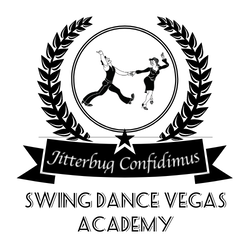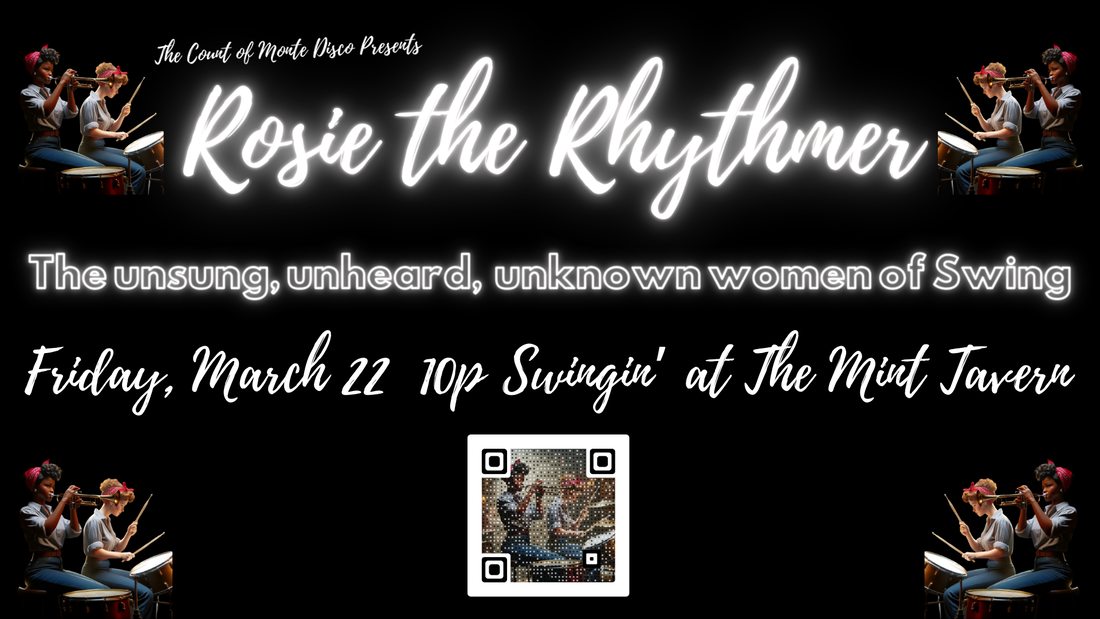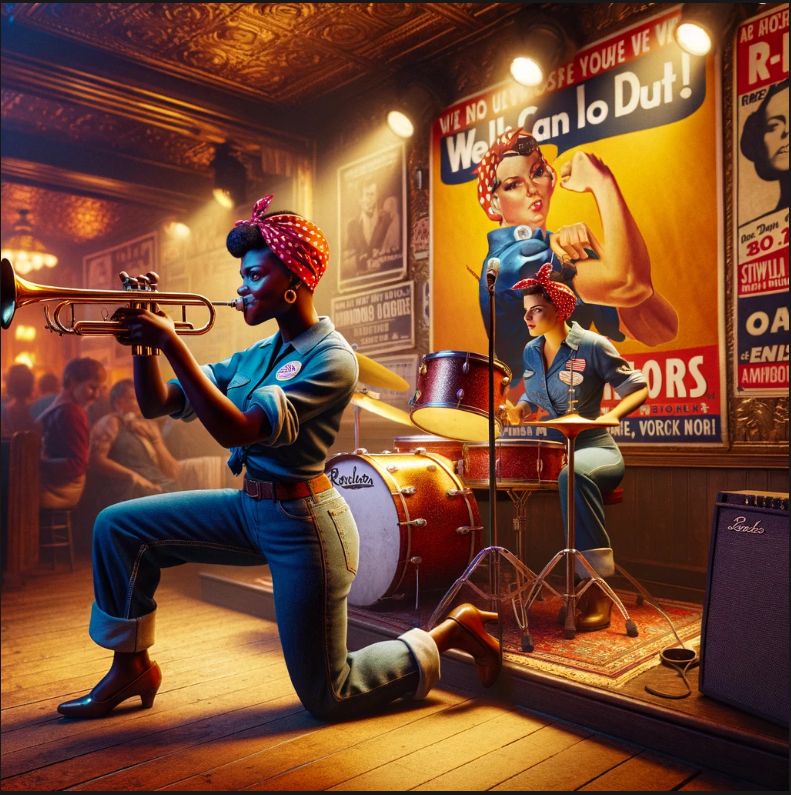Rosie the rhythmer
the unsung, unheard, and unknown women of Swing
Rosie the Rhythmer
The Unsung, Unheard, unknown women of swing
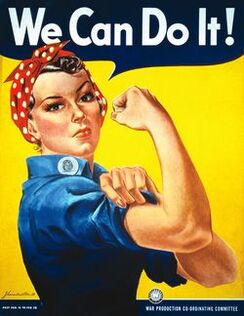 The image of Rosie the Riveter was created by Normal Rockwell on May 29, 1943.
The image of Rosie the Riveter was created by Normal Rockwell on May 29, 1943.
In the pages of history, the contributions of women - particularly those outside of the dominant social culture - are frequently overlooked. Often reduced to background characters serving as tools to explain the actions of their male counterparts, female participation in historical movements is minimal. Regrettably, the narratives surrounding Jazz and Swing history are no exception, with the impact of female musicians often downplayed or outright ignored. Academic discussions of these talented women have at times been dismissive, disrespectful, and rife with misogyny. For instance, one notable historian of the Swing Era seemed incapable of praising the skills of these female players without making disparaging remarks about their physical appearance.
In no way is this set intended to be exhaustive, definitive, or complete regarding the history of women in the Jazz & Swing era. Nor will this set attempt to contextualize the challenges encountered by these skilled individuals and groups. The difficulties in being female in a male dominated industry; the obstacles they faced to the freedom inherent in the American Dream and Jazz music; the constant pulls of "traditional" cultures; and the burdens of sexual assumptions are best suited for other mediums...and a great place to start is the excellent documentary, "The Girls in the Band" (2011) . (This may be available at your local library, as it is here in Las Vegas). For a more detailed treatment on the role of women musicians in the Swing era, check out the seminal, "Swing Shift: 'All-Girl' Bands of the 1940s" by Sherrie Tucker.
However, if you can listen (or dance) through this and walk (or dance) away with a greater appreciation for the talent of the musicians showcased - and without the need for a gendered qualifier - then the set has accomplished its purpose.
But before we begin...a few quick notes
|
This set showcases just a few of the important female vocalists, instrumentalists, and bandleaders of the 1920s-1940s...but only a few. For instance, Ivy Benson is not mentioned below, almost entirely because she is British. For reasons, solo female vocalists (e.g., Helen Forrest or Mildred Bailey), vocal trios (e.g., the important and very over-played Andrew Sisters), and dancer/entertainers (e.g., Norma Miller) were not included. This is not a comment on their talent or contributions.
For other reasons, this set omits the brilliant influence of Mary Lou Williams. This may be a comment on the talent and contribution of the set creator. Finally, it is no mere coincedence that all of the females discussed below are identified as African-American or bi-racial, with both "all-girl" bands being composed of members from a variety of races and ethnicities. That these artists are unsung, unheard, and unknown is not a surprise. But after you hear them sing and get to know them a little better, you will not be surprised to learn how their artistry shaped and changed American popular music. |
So...how do you begin a set discussing the underappreciated and unknown female instrumentalists, vocalists and bandleaders of the Swing era? Easy...you start where you left off last month.
Lil Hardin ArmstronG - Piano, vocals, bandleader

Lil Hardin Armstrong (née Hardin) has perhaps the most outsized role in American popular music - convincing her second husband, Louis Armstrong, to step out of from the shadow of King Joe Oliver and to start his own band.
Yet, Hardin Armstrong was herself a pioneer. She started the piano in third grade and studied music at Fisk University, a HBCU in Nashville. When she began playing professionally in Chicago at the age of 20, Hardin Armstrong quickly realized that her musical education surpassed those of the famed New Orleanian musicians who were popular around town. Over the course of two decades, she led the rhythm section for bandleaders like Oliver, Armstrong, and Freddie Keppard (whom she considered the second greatest trumpet player of all time, behind Louis). Hardin Armstrong was also the piano player (and only female) on the seminal Hot 5 and Hot 7 recordings, that are considered to be the most important records in the history of Swing.
In the mid-1930s, Hardin Armstrong would lead an "all-girls" band around the nation.
Lil Hardin Armstrong continued to play music until her death, on stage, in 1971.
Yet, Hardin Armstrong was herself a pioneer. She started the piano in third grade and studied music at Fisk University, a HBCU in Nashville. When she began playing professionally in Chicago at the age of 20, Hardin Armstrong quickly realized that her musical education surpassed those of the famed New Orleanian musicians who were popular around town. Over the course of two decades, she led the rhythm section for bandleaders like Oliver, Armstrong, and Freddie Keppard (whom she considered the second greatest trumpet player of all time, behind Louis). Hardin Armstrong was also the piano player (and only female) on the seminal Hot 5 and Hot 7 recordings, that are considered to be the most important records in the history of Swing.
In the mid-1930s, Hardin Armstrong would lead an "all-girls" band around the nation.
Lil Hardin Armstrong continued to play music until her death, on stage, in 1971.
Lovie Austin - PIANO, VOCALS, BANDLEADER

Like many of the women in this set, Lovie Austin rose to prominence in Chicago, a city full of the music of southern migrants, especially New Orleans. Throughout the 1920s and 1930s, Lovie Austin would lead her own band, The Blues Serenaders, composed mainly of men from New Orleans throughout the midwest. However, Austin's influence extended beyond that of just jazz music.
In the early 1920s, Austin wrote songs and recorded piano for various blues shouters, including seminal singers, Ma Rainey, Alberta Hunter, and Bessie Smith. She was also to influence the previously-mentioned Mary Lou Williams, who wrote in her autobiography that Austin was "a fabulous woman and a fabulous musician too. I don't believe there's a woman around now who could compete with her. She was a greater talent than many of the men of this period."
Austin spent the final 20 years of her career as the musical director for a Chicago theater on the T.O.B.A. circuit.
In the early 1920s, Austin wrote songs and recorded piano for various blues shouters, including seminal singers, Ma Rainey, Alberta Hunter, and Bessie Smith. She was also to influence the previously-mentioned Mary Lou Williams, who wrote in her autobiography that Austin was "a fabulous woman and a fabulous musician too. I don't believe there's a woman around now who could compete with her. She was a greater talent than many of the men of this period."
Austin spent the final 20 years of her career as the musical director for a Chicago theater on the T.O.B.A. circuit.
Blanche Calloway - Vocals, bandleader

Blanche Calloway came from a musical family (you've probably heard of her younger brother). Against her mother's wishes, Calloway dropped out of college to pursue a career in music. Initially, she was a dancer and chours girl in the early African-American musicals on Broadway, including Shuffle Along (1921). Her star rose on a national tour of Plantation Days, starring Black icon Florence Mills with music by James P. Johnson (of "Charleston" fame).
When that tour ended in Chicago in 1927, Calloway stayed to make her home in the second city of jazz. There she played with the best musicians, including as the female singer for the great Kansas City Andy Kirk and His Twelve Clouds of Joy (which featured a young Mary Lou Williams on piano and arrangement).
In 1931, Calloway became the first female to lead an all-male band, as the aptly named, Blanche Calloway an Her Joy-Boys. The Joy-Boys were comprised of many of the same musicians who played with Lovie Austin and Lil Hardin Armtrong, including Kid Ory, Johnny Dodds, and Johnny St. Cyr - all of whom played on the original Hot 5 recordings with Lil and her husband, Louis.
Calloway would continue to play music through the 1930s and 1940s, though the challenges she faced diminished her success. Eventually, Calloway would move to Washington D.C., where she managed a nightclub and an up-and-coming rhythm & blues singer named Ruth Brown.
Even while overshadowed by the popularity of her charismatic sibling, Cabell III, Calloway's influence can be defined. In 1931, Cab Calloway would release the song that would become his signature tune and denote him as "The Hi-De-Ho Man." However, earlier in 1931, Blanche Calloway and Her Joy-Boys released the first of her three songs in this set. For fun, pay attention to the first three words she sings.
When that tour ended in Chicago in 1927, Calloway stayed to make her home in the second city of jazz. There she played with the best musicians, including as the female singer for the great Kansas City Andy Kirk and His Twelve Clouds of Joy (which featured a young Mary Lou Williams on piano and arrangement).
In 1931, Calloway became the first female to lead an all-male band, as the aptly named, Blanche Calloway an Her Joy-Boys. The Joy-Boys were comprised of many of the same musicians who played with Lovie Austin and Lil Hardin Armtrong, including Kid Ory, Johnny Dodds, and Johnny St. Cyr - all of whom played on the original Hot 5 recordings with Lil and her husband, Louis.
Calloway would continue to play music through the 1930s and 1940s, though the challenges she faced diminished her success. Eventually, Calloway would move to Washington D.C., where she managed a nightclub and an up-and-coming rhythm & blues singer named Ruth Brown.
Even while overshadowed by the popularity of her charismatic sibling, Cabell III, Calloway's influence can be defined. In 1931, Cab Calloway would release the song that would become his signature tune and denote him as "The Hi-De-Ho Man." However, earlier in 1931, Blanche Calloway and Her Joy-Boys released the first of her three songs in this set. For fun, pay attention to the first three words she sings.
valaida Smith - trumpet, vocals, bandleader
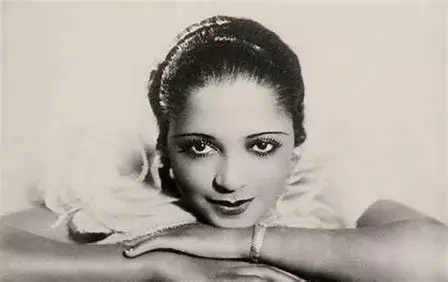
When W.C. Handy, known as the Father of the Blues, first heard Valaida Snow play trumpet, he said she was the second best trumpet player he had ever heard, behind only Louis Armstrong. When Ol' Satchmo heard her for the first time, he exclaimed, "Boy, I have never heard anything that great!"
Valaida Snow was a musical prodigy, playing the cello, bass, banjo, violin, mandolin, harp, accordion, clarinet, saxophone, and trumpet by the age of 15. Snow performed in the budding Black Broadway scene, making her debut in the failed follow-up to the 1921 musical Shuffle Along, In Bamville. From New York, she would make her way around the country both as a lead trumpet player for male bands or as the bandleader herself.
In a story all too common, Snow found the racial and gendered climate of the United States more stifling than that of Europe, where her popularity reached new heights in the 1930s. Tragically, Snow was arrested in Denmark in 1941 for possession and placed in a Nazi-occupied prison for almost a year. She was released in May 1942 as part of a prisoner exchange, but her health and fame never recovered. She passed away backstage at a New York City show in 1956 - three days before her 52nd birthday.
Valaida Snow was a musical prodigy, playing the cello, bass, banjo, violin, mandolin, harp, accordion, clarinet, saxophone, and trumpet by the age of 15. Snow performed in the budding Black Broadway scene, making her debut in the failed follow-up to the 1921 musical Shuffle Along, In Bamville. From New York, she would make her way around the country both as a lead trumpet player for male bands or as the bandleader herself.
In a story all too common, Snow found the racial and gendered climate of the United States more stifling than that of Europe, where her popularity reached new heights in the 1930s. Tragically, Snow was arrested in Denmark in 1941 for possession and placed in a Nazi-occupied prison for almost a year. She was released in May 1942 as part of a prisoner exchange, but her health and fame never recovered. She passed away backstage at a New York City show in 1956 - three days before her 52nd birthday.
Ina Ray Hutton - Vocals, Bandleader
By 8 years old, Ina Ray Hutton (born Odessa Cowan) was a veteran of the stages of Chicago. At 15, she was a veteran of Broadway. Which is to say that while not a muscian, Ina Ray Hutton had the charisma and personality to stand out on stage.
Her legendary stage presence led her to prominence as the leader of one of the first all-female bands, Ina Ray Hutton and Her Melodears, formed in 1934. Five years later, the Ina Ray Hutton Orchestra began touring - composed of Hutton leading an all-male big band. In the early 1950s, Hutton returned to an all-female swing band for the eponymous Ina Ray Hutton Show.
Her legendary stage presence led her to prominence as the leader of one of the first all-female bands, Ina Ray Hutton and Her Melodears, formed in 1934. Five years later, the Ina Ray Hutton Orchestra began touring - composed of Hutton leading an all-male big band. In the early 1950s, Hutton returned to an all-female swing band for the eponymous Ina Ray Hutton Show.
The International Sweethearts of rhythm - all female band
The International Sweethearts of Rhythm had as an inauspicious a start as any band could. The original members were students at the Piney Woods Country Life School for poor and African-American students in Mississipi. The school's founder and principal, Lawrence Jones, was inspired by Ina Ray Hutton and Her Melodears.
Initially, the all-female student band toured to raise money for the school; however by 1941 (three years after forming), the Sweethearts severed ties with the institution to become a professional band based out of Virginia. By this time, the band was composed of an "international" cadre of members, including African-American, caucasion, Latina, Chinese, and Native American, among others. The band found their most success working for the USO entertaining servicemen during WWII. They were especially popular amongst the Black regiments.
Like all female-composed bands of the 1940s, the end of the war meant the end of the line for The International Sweethearts of Rhythm. Stuck in Europe for the last 6 months of the war, six of the band members were said to quit the day they returned to the states following the German surrender. The remaining members would not last the year.
However, like all the female artists featured here, the influence of the International Sweethearts of Rhythm is undeniable and their compilation album from 1942 was selected by the Library of Congress for being "culturally, historically, or aesthetically significant."
And as an aside, the drummer for The International Sweethearts of Rhythm is one of the best of the Swing era. Full stop. Pauline Braddy is excellent.
Initially, the all-female student band toured to raise money for the school; however by 1941 (three years after forming), the Sweethearts severed ties with the institution to become a professional band based out of Virginia. By this time, the band was composed of an "international" cadre of members, including African-American, caucasion, Latina, Chinese, and Native American, among others. The band found their most success working for the USO entertaining servicemen during WWII. They were especially popular amongst the Black regiments.
Like all female-composed bands of the 1940s, the end of the war meant the end of the line for The International Sweethearts of Rhythm. Stuck in Europe for the last 6 months of the war, six of the band members were said to quit the day they returned to the states following the German surrender. The remaining members would not last the year.
However, like all the female artists featured here, the influence of the International Sweethearts of Rhythm is undeniable and their compilation album from 1942 was selected by the Library of Congress for being "culturally, historically, or aesthetically significant."
And as an aside, the drummer for The International Sweethearts of Rhythm is one of the best of the Swing era. Full stop. Pauline Braddy is excellent.
So...how do you end a set discussing the underappreciated and unknown female instrumentalists, vocalists and bandleaders of the Swing era? Easy...
You play a song by the most appreciated, most well known female vocalist, instrumentalist, and bandleader of all time.
You play a song by the most appreciated, most well known female vocalist, instrumentalist, and bandleader of all time.
Ella Fitzgerald - queen
Resources
- Tucker, Sherrie. Swing Shift: "All-Girl" Bands of the 1940s. Duke University Press, 2000.
- "The Girls in the Band." directed by Judy Chaikin, 2011.
- "Women of the Big Band Era." Vintage Inn, 2016, www.vintageinn.ca/2016/03/women-of-the-big-band-era/.
- "The Forgotten Women Who Made Modern Jazz" The New York Times, 22 April 2020, www.nytimes.com/2020/04/22/arts/music/women-jazz-musicians.html.
- "Best of the All-Women Swing Bands." Medium, 2021, https://medium.com/@wewanick/the-best-of-the-all-women-swing-bands-923e8bd509b2.
